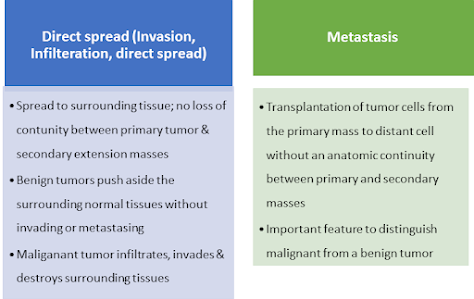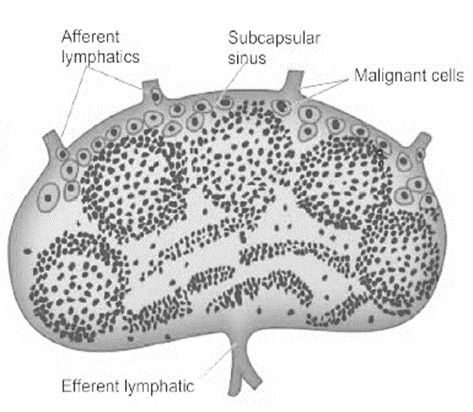Cancer B Pharma 2nd Semester Pathophysiology notes pdf

Cancer B Pharma 2nd Semester Pathophysiology notes pdf
Objective
At the end of this lecture, student will be able to
• Define the term “Tumor”
• List main characteristics of benign and malignant cancer
• Describe the nomenclature used for various types of tumors
• Explain the mechanism of spread of tumors
CANCER
General biology of cancer
Neoplasm/ Tumour – “A mass of tissue formed as a result of abnormal, excessive, uncoordinated, autonomous and purposeless proliferation of cells”
• Oncology – Branch of science dealing with the study of neoplasm
• Transformation from a living normal cell into a living tumor cell
Basic features of change in neoplasia
• Change is irreversible; becomes fixed character of a transformed cell
• Acquired fixed character is heritable; tumor cell divide to give tumor cell
• Change once occurred is self-perpetuating
• Tumor cell has uncontrolled passion for continued proliferation
Classification of tumors
• Based on the nature of tumors, they are classified as
Benign tumor – Harmless and self-limited
Malignant tumor – Harmful and rapidly growing
• Names of every tumor ends with ‘oma’
• Malignant tumor of epithelial tissue – Carcinoma
• Malignant tumor of connective tissue – Sarcoma
Classification of tumor based on tissue of origin
| Tissue of origin | Benign | Malignant |
| Epithelial tumors | ||
| 1. Squamous epithelium | Squamous cell papilloma | Squamous cell carcinoma |
| 2. Transitional epithelium | Transitional epithelium papilloma | Transitional epithelium carcinoma |
| 3. Glandular epithelium | Adenoma | Adenocarcinoma |
| 4. Hepatocytes | Liver cell adenoma | Hepatocellular carcinoma (Hepatoma) |
| Tissue of origin (Non epithelial tumors) | Benign | Malignant |
| Adipose tissue | Lipoma | Liposarcoma |
| Fibrous tissue | Fibroma | Fibrosarcoma |
| Cartilage | Chondroma | Chondrosarcoma |
| Bone | Osteoma | Osteosarcoma |
| Blood vessels | Haemangioma | Angiosarcoma |
| Nerve cells | Ganglia Neuroma | Neuroblastoma |
Contrasting features of benign and malignant tumor
| Features | Benign | Malignant |
| Macroscopic features | ||
| Encapsulated/ well circumscribed | Irregular & poorly circumscribed |
| 2. Surrounding tissues | Often compressed | Usually invaded |
| Usually small | Often large |
| 4. Secondary changes | Occurs less often | Occurs more often |
| Microscopic Features | ||
| Closely resembles the tissue of origin | Poor resemblance to the tissue of origin |
| 2. Basal polarity | Retained | Lost |
| 3. Pleomorphism | Normal | Increased |
| 4. Neuclio- cytoplasmic ratio | Normal | Increased |
| Absent | Present |
| Always typical mitosis | Atypical & abnormal mitosis |
| 7. Tumor giant cells | May be present but with atypical nucleus | Always present with atypical nucleus |
| 8. Cytoplasm | With normal constituents | Elements are reduced or lost |
| 9. Functions | Usually well maintained | Retained/ lost/ abnormal |
| Growth rate | Usually slow | Rapid |
| Local invasion | Often compresses the surroundings; no invasion/ infiltration | Invade & infiltrate the adjacent tissue |
| Metastatis (Spreading) | Absent | Present |
Structure of tumor
Tumor mass consists of:
- Parenchyma
- Stroma
Parenchyma
• Formed by proliferating tumor cells
• Parenchyma of benign tumor – organised pattern with resemblance to tissue of origin, differentiation
• Parenchyma of malignant tumor – unorganised, atypical, distorted, relation of tumor cell with basement is lost, anaplasia
Stroma
• Supporting tissue of tumor
• Consists of fibrous tissue carrying blood vessels for nourishing tumor cell
• More malignant the tumor, Cirrhous
• Carcinoma with scanty stroma – celluloid & medullary
• New blood vessels form from pre existing onesless is the fibrous tissue
• Carcinoma with extensive stroma – with the help of a factor, “tumor angiogenesis factor”
Spread of cancer
(Two mechanism for the spread of cancer)
Routes of spread of cancer
1. Infiltration of tissue spaces
• Tissue spaces – preformed passages; paths of least resistance
• Most vulnerable tissues – soft tissues – adipose, muscle,
• Gamete/ compact tissues like capsule of organs, cartilage and bone (not marrow) offer greater resistance
• Tissue subjected to infiltration are destroyed by the proteolytic enzymes & lytic substances elaborated by cancer tissue
• Tissue space invasion brings the tumor cell in direct contact with normal cells, lymphatic and blood vessels
2. Hematogenous spread:
• Carcinoma of lungs, thyroid, kidney and the prostate spread through blood vessels
Tumor cells enter blood stream by 2 ways
- Via thorasic duct – either by perforation of vein or by lymphatic drainage
- By direct invasion of blood vessels (large veins, venules & capillaries); arteries not involved due to their thick wall
3. Spread via lymphatics: Most common with carcinoma; results in both invasion & metastasis
Spread via lymphatics
Lymphatic spread begins by lodgement of tumour cells in subcapsular sinus via afferent lymphatics entering at the convex surface of the lymph node
Hematogenous spread
4. Spread via serous sacs
• Spread through peritoneal cavity; common in cancer of GIT & ovary
• Trans pleural spread – in carcinoma of lungs and breast
• Trans pericardial spread may also occur
5. Spread along epithelium line surfaces
• Intact epithelium, mucous coat acquires resistance for penetration of tumor
• Implantation tumor – tumor spread along the surface of epithelium
6. Spread via CSF
• Cerebrospinal cavities are affected by the escape of tumor cells from
• the malignant tumor in the brain or meninges
Summary
• A tumour is a mass of tissue formed as a result of abnormal, excessive, uncoordinated, autonomous and purposeless proliferation of cells
• Tumors are classified as benign and malignant
• Benign tumors are harmless and do not spread while malignant tumors are harmful and spread
• Tumor is made up of parenchyma and stroma
• Tumor spread by two mechanism – Haematogenous spread and lymphatic spread
Cancer FAQ
Q1: What is a tumor? A tumor is an abnormal mass of tissue that results from the uncontrolled growth of cells. Tumors can be benign (non-cancerous) or malignant (cancerous).
Q2: What are the main characteristics that distinguish benign and malignant tumors? Benign tumors are typically well-defined, slow-growing, and remain localized. They do not invade nearby tissues or metastasize. Malignant tumors, on the other hand, are fast-growing, invasive, and can spread to other parts of the body, leading to the potential for cancer.
Q3: How are tumors named, and what is the nomenclature used for various types of tumors? Tumors are named based on their tissue of origin and their characteristics. Nomenclature typically includes the type of tissue, cell type, and whether the tumor is benign or malignant. For example, “Adenocarcinoma of the lung” refers to a malignant tumor originating from glandular cells in the lung.
Q4: Can you explain the mechanism of tumor spread or metastasis? Metastasis is the process by which cancer cells spread from the primary tumor to other parts of the body. It involves several steps, including:
- Invasion: Cancer cells break through nearby tissues.
- Intravasation: Cancer cells enter the bloodstream or lymphatic system.
- Circulation: Cancer cells travel to distant sites in the body.
- Extravasation: Cancer cells exit the bloodstream or lymphatic system.
- Colonization: Cancer cells establish new tumors at distant sites.
Q5: What are some common risk factors for the development of cancer? Common risk factors for cancer include exposure to carcinogens (such as tobacco and asbestos), genetic factors, a weakened immune system, chronic inflammation, radiation exposure, and some viral infections.
Q6: What are the most common types of cancer, and how are they typically diagnosed and treated? Common types of cancer include lung, breast, prostate, and colorectal cancer. Diagnosis often involves imaging tests, biopsies, and blood tests. Treatment options may include surgery, chemotherapy, radiation therapy, immunotherapy, targeted therapy, and palliative care.
Q7: How can cancer be prevented or early detection be promoted? Cancer prevention strategies include a healthy lifestyle (such as avoiding tobacco and limiting alcohol consumption), vaccination against cancer-related viruses (like HPV), and early screening through methods like mammography, colonoscopy, and PAP smears. Early detection is crucial for better treatment outcomes.
Q8: What are the stages of cancer, and how do they affect treatment and prognosis? Cancer staging is a way to describe the extent of cancer’s spread. It helps determine treatment options and prognosis. Stages range from 0 (in situ, localized) to IV (advanced, with distant metastases). The earlier the stage, the better the prognosis and treatment options.
Q9: What role does genetics play in cancer risk, and how can genetic testing be used to assess cancer susceptibility? Genetics can play a significant role in cancer risk. Certain genetic mutations increase susceptibility. Genetic testing can identify these mutations and help assess an individual’s risk, enabling early preventive measures and personalized treatment strategies.
Q10: What are the most promising advancements in cancer research and treatment in recent years? Recent advancements in cancer research include immunotherapy, targeted therapies, and precision medicine. These approaches aim to treat cancer more effectively while minimizing side effects.




